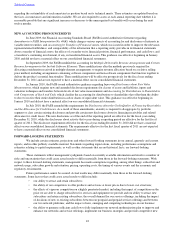Sprint - Nextel 2010 Annual Report Download - page 35
Download and view the complete annual report
Please find page 35 of the 2010 Sprint - Nextel annual report below. You can navigate through the pages in the report by either clicking on the pages listed below, or by using the keyword search tool below to find specific information within the annual report.
Equipment Net Subsidy
We recognize equipment revenue and corresponding costs of devices when title of the device passes to the dealer or
end-user customer. Our marketing plans assume that devices typically will be sold at prices below cost, which is consistent with
industry practice, as subscriber retention efforts often include providing incentives to subscribers such as offering new devices
at discounted prices. We reduce equipment revenue for these discounts offered directly to the customer, or for certain payments
to third-party dealers to reimburse the dealer for point of sale discounts that are offered to the end-user subscriber. Additionally,
the cost of devices is reduced by any rebates that are earned from the supplier. Cost of devices and accessories also includes
order fulfillment related expenses and write-downs of device and related accessory inventory for shrinkage and obsolescence.
Equipment cost in excess of the revenue generated from equipment sales is referred to in the industry as equipment net subsidy.
Equipment revenue increased $749 million, or 38%, in 2010 compared to 2009 and cost of devices increased $1.4 billion, or
26%, in 2010 compared to 2009. The increase in both equipment revenue and cost of devices is primarily due to an increase in
the number of postpaid devices sold with a greater mix of devices that have a higher average sales price and cost, as well as an
increase in the number of prepaid devices sold. Equipment revenue decreased $38 million, or 2%, in 2009 compared to 2008
primarily due to declining average sales prices for devices with higher functionality as a result of competitive and economic
pressures, partially offset by an increase in the number of lower priced prepaid devices sold in 2009 as compared to 2008. Cost
of devices increased $699 million, or 15%, in 2009 compared to 2008, primarily due to our mix of devices sold reflecting a
greater mix of postpaid devices sold with a higher functionality and an increase in the number of devices sold.
Selling, General and Administrative Expense
Sales and marketing costs primarily consist of customer acquisition costs, including commissions paid to our indirect
dealers, third-party distributors and retail sales force for new device activations and upgrades, residual payments to our indirect
dealers, payroll and facilities costs associated with our retail sales force, marketing employees, advertising, media programs
and sponsorships, including costs related to branding. General and administrative expenses primarily consist of costs for
billing, customer care and information technology operations, bad debt expense and administrative support activities, including
collections, legal, finance, human resources, strategic planning and technology and product development.
Sales and marketing expense increased $322 million, or 7%, in 2010 from 2009 as compared to a decrease of $273
million, or 6%, in 2009 from 2008. The increase in sales and marketing expenses for the year ended December 31, 2010 is
primarily due to the additional costs associated with our increase in subscriber gross additions combined with incremental costs
associated with our business combinations in the fourth quarter 2009, offset by a decline in marketing expenditures related to
our cost cutting initiatives. The decline in sales and marketing expenses for the year ended December 31, 2009 is primarily due
to a decline in gross subscriber additions compared to 2008 and a decline in labor related costs due to our workforce and cost
reduction activities.
General and administrative costs decreased $203 million, or 5%, in 2010 from 2009 and $1.1 billion, or 22%, in
2009 from 2008. The decline in general and administrative costs for the year ended December 31, 2010 reflects a reduction in
customer care costs and minor continued effects of workforce reductions and cost cutting initiatives announced in 2009 offset
by increases as a result of the fourth quarter 2009 business combinations of Virgin Mobile and iPCS in addition to an increase
in bad debt expense. The decline in general and administrative costs for the year ended December 31, 2009 is primarily due to
reductions in customer care costs, the decrease in employee related costs as part of our cost cutting initiatives and lower bad
debt expense. Customer care costs decreased $87 million in 2010 as compared to 2009 and $363 million in 2009 as compared
to 2008. The improvement in customer care costs is largely attributable to customer care quality initiatives launched in 2008
that have resulted in a reduction in calls per subscriber by 39% from 2007 peak levels which allowed for a reduction of 19 call
centers in 2009 and 11 call centers in 2008. Employee related costs in 2010 were consistent with 2009 and costs decreased
approximately $536 million in 2009 as compared to 2008, due to workforce reductions announced in January and November
2009. Bad debt expense was $423 million for the year ended December 31, 2010 representing a $31 million increase, as
compared to bad debt expense of $392 million in 2009. The increase in bad debt expense primarily reflects 2009 reductions in
allowances for bad debt due to increased rates of recovery. For the year ended December 31, 2009, bad debt expense decreased
$240 million as compared to bad debt expense of $632 million in 2008. The improvement in bad debt expense resulted from
lower rates of uncollectibility during the period, as well as lower estimated uncollectible accounts in outstanding accounts
receivable. We reassess our allowance for doubtful accounts quarterly. Changes in our allowance for doubtful accounts are
largely attributable to credit policies established for subscribers and analysis of historical collection experience. Our mix of
prime postpaid subscribers to total postpaid subscribers remained flat at 84% as of December 31, 2010 and 2009, respectively.
Table of Contents
33
























